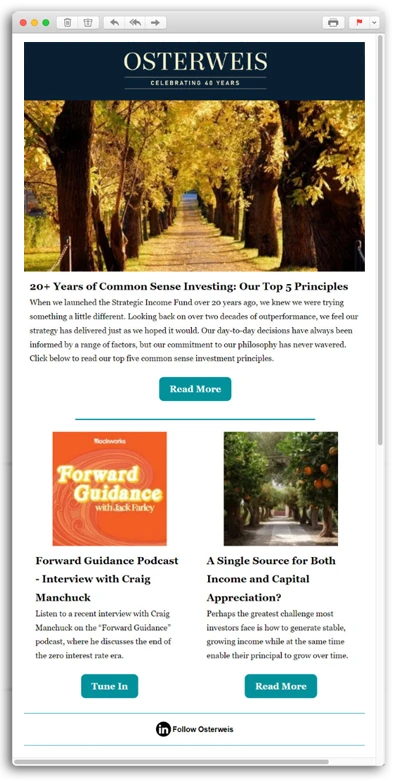Fourth Quarter Growth & Income Outlook
Published on October 21, 2024
Investing in rapidly growing economies like China is a tempting proposition, but we believe that domestic companies have the advantage in the long run, particularly because the U.S. has important demographic advantages.
Invest in the Best, Avoid the Rest
We are often asked why we prefer investing primarily in U.S.-based businesses. This is an important question to consider, particularly since countries like China, Brazil, and India have all experienced rapid and sustained economic growth over the past few decades, and they each are home to companies that meet our rigorous investment criteria for both equities and fixed income.
In this outlook, we explain why we believe the benefit of investing internationally, even in rapidly growing economies, often does not outweigh the risk. We use China as a case study for this discussion, but many of the observations we make about China apply to other countries as well. Our analysis reinforces our view that the U.S. continues to provide the most attractive investment environment, and our country’s persistent population growth appears to be an additional and underappreciated advantage that could last for decades.
China: Exceptional Growth Has Not Translated into Superior Returns
China is in many ways the poster child for well-managed, rapid economic growth, yet equity returns in the country have lagged those in the U.S. for the past 20 years.
Starting in 1978, a succession of Chinese leaders made significant reforms to China’s economy and opened the country to outside investment and increased trade, culminating in China’s joining the WTO in 2001. More recently, an escalating trade war with the U.S. and the EU have dented trade, but the Chinese economy continues to grow.
Amazingly, real GDP growth (which adjusts for inflation) in China since 1978 has been positive every single year, and real GDP has grown at roughly 9% annually over that period. Real GDP per capita (which measures the economic benefits adjusting for population growth) has exploded, growing over 10% annually since 1978.
As a result, nearly 800 million Chinese escaped poverty over the last 40 years. China now has the second largest economy in the world, after the U.S. Adjusting for purchasing power parity, which considers currency effects by country, China actually has the largest economy in the world.
Based on the economic data and the fact that China’s living standards have dramatically improved, the policies implemented by China’s leadership have clearly worked in terms of economic expansion. However, shareholder returns do not reflect all this good economic news.
In fact, according to Bloomberg, over the past two decades, the S&P 500 has delivered roughly 2.5x higher returns cumulatively than the Shanghai Composite Index. This is despite a massive stimulus currently being implemented in China that has dramatically boosted shareholder returns in recent weeks. Interestingly, the MSCI Emerging Markets Index has compounded only a bit more than the Shanghai Composite Index according to Bloomberg, with both generating roughly 7% annualized returns over the past 20 years.
The gap in shareholder returns can be chalked up to a number of factors — from government policies that inhibit large companies from amassing too much economic power, to lack of protections and legal recourse for shareholders, to geopolitical instability, to overreliance on key commodity sectors. Regardless of the cause, the wide gap between S&P 500 returns and those of Chinese and emerging market equities reflects our long-held concerns about investing outside the U.S., and we do not see these risks abating.
Looking forward, we worry that declining populations in key economies could represent an increasing threat to investors.
The Demographic Threat, Through the Lens of China
The French philosopher and sociologist Auguste Comte once said that “demography is destiny.” We largely agree with this sentiment and view a growing population as a key driver of economic growth and dynamism, among other factors. If we are correct, the economic health of China (as well as some other countries) appears set to deteriorate. Demographically, China looks like countries in Europe and Asia that have achieved economic scale: They experienced rapid population growth that helped power their robust economic expansion before population growth slowed and eventually declined, leading to weakening economic activity.
China’s annual population growth has averaged roughly 1% since 1960, steadily increasing from roughly 670 million people in 1960 to over 1.4 billion people in 2021. This increase was critical to the country’s sustained economic growth, as population growth increased consumption and justified massive investment in infrastructure and government programs.
However, the Chinese population peaked in 2021 and contracted in both 2022 and 2023. The U.N. projects that China’s population could contract to just 639 million people by 2100, implying annual population decline of 1% annually for the next roughly 75 years. This decline can be attributed to a number of factors, from the one-child policy implemented in 1980 (and since amended) to lower fertility rates in general due to rapid urbanization. Regardless, the population has begun shrinking and is expected to continue shrinking for decades to come. Of course, policies promoting larger families and an improved social welfare system could dampen the magnitude of these demographic changes, but consistent population decline appears to be inevitable.
If this population decline materializes, the demographic headwind could create a multitude of issues for China. We believe most of these same threats exist for other countries with flat to declining populations, including Japan and several in western Europe:
- Shrinking working-age population: The Chinese working-age population peaked in 2011 at more than 900 million people; this could shrink to 700 million people by mid-century. These workers will have to support roughly 500 million Chinese aged 60 and over, compared with 200 million today. A shrinking working age population could put more pressure on the social welfare system. China recently announced a delay in the retirement age and increased the number of years the Chinese have to pay into social security in order to receive retirement benefits. This could put further pressure on already heavily indebted local and central governments.
- Declining real estate values: The recent property slump China is facing could become an acute crisis as excess housing sees persistent declines in demand with a shrinking population. Some estimates claim that China already has excess housing for 150 million people, and that is before taking into account the declining population. Add in debt tied to the real estate sector and the fact that 70% of family wealth in China is currently tied up in real estate, and the economic impacts to the country could be severe.
- Increasing labor costs: Chinese labor costs have already begun rising and now exceed those of other countries like Thailand, Mexico, and India. Increasing labor costs can make manufacturing much more costly for countries with shrinking populations.
- Shrinking pool of consumers: Consumption plays an important role in virtually every developed economy; assuming China shifts to a more consumption-based economy like most economic juggernauts from the U.S. to western Europe to Japan, a shrinking Chinese population could represent a major headwind to economic expansion in China.
Looking to the Future: U.S. Increasingly in the Catbird Seat
The U.S. population of roughly 335 million is growing at over 1% annually due largely to immigration. The U.S. has a long history of immigration, and a recent uptick has driven the increase in our population growth rate to a pace not seen since the early 1990s. This increase could help offset wage inflation while also increasing consumption and help bolster the future size of the working age population in the U.S. These trends stand in stark contrast to the demographic picture in Europe, Japan, and China, which together represent almost 40% of global GDP.
Admittedly, a declining population is not deterministic of poor equity returns. Japan’s population peaked in 2010 and has declined at nearly 1% annually since then, yet equity returns for the Nikkei have been reasonably attractive (though still well below those of the S&P 500) since that period. However, a persistently shrinking population creates substantial added risk in our view and thus makes investing outside the U.S. that much more potentially treacherous.
The U.S. sits in a uniquely attractive position. It has the largest global economy made up of some of the most successful and profitable businesses in the world, a pro-corporate economic and political system, significant natural resources with a massive domestic market, and is surrounded by natural land and sea barriers. And if demography truly is destiny, our growing population that benefits from an openness to immigration means the future is that much brighter for the U.S. We intend to continue investing primarily in domestic stocks and bonds, confident in our future growth and continued economic dominance.
We thank you for your confidence in our management.
John Osterweis
Founder, Chairman & Co-Chief Investment Officer – Core Equity
Gregory Hermanski
Co-Chief Investment Officer – Core Equity
Nael Fakhry
Co-Chief Investment Officer – Core Equity
Carl Kaufman
Co-President, Co-Chief Executive Officer, Chief Investment Officer – Strategic Income & Managing Director – Fixed Income
The Osterweis Funds are available by prospectus only. The Funds’ investment objectives, risks, charges, and expenses must be considered carefully before investing. The summary and statutory prospectuses contain this and other important information about the Funds. You may obtain a summary or statutory prospectus by calling toll free at (866) 236-0050, or by visiting www.osterweis.com/statpro. Please read the prospectus carefully before investing to ensure the Fund is appropriate for your goals and risk tolerance.
Mutual fund investing involves risk. Principal loss is possible.
Past performance does not guarantee future results.
This commentary contains the current opinions of the authors as of the date above, which are subject to change at any time, are not guaranteed, and should not be considered investment advice. This commentary has been distributed for informational purposes only and is not a recommendation or offer of any particular security, strategy, or investment product. Information contained herein has been obtained from sources believed to be reliable but is not guaranteed.
No part of this article may be reproduced in any form, or referred to in any other publication, without the express written permission of Osterweis Capital Management.
Current and future holdings are subject to risk.
Gross Domestic Product (GDP) is the monetary value of all the finished goods and services produced within a country’s borders in a specific time period.
The S&P 500 Index is widely regarded as the standard for measuring large cap U.S. stock market performance. The index does not incur expenses, is not available for investment, and includes the reinvestment of dividends.
Osterweis Capital Management is the adviser to the Osterweis Funds, which are distributed by Quasar Distributors, LLC. [OCMI-624182-2024-10-16]








